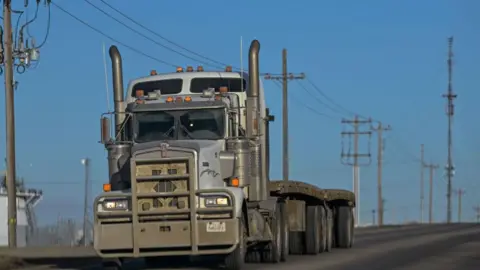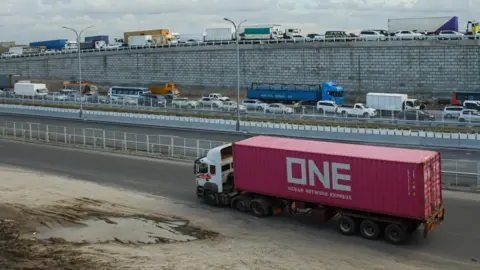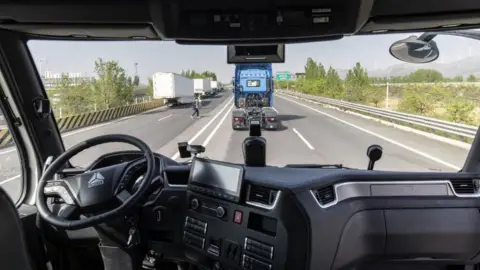Sam GruteTechnology Reporter, Vancouver
 Getty Images
Getty ImagesWhen Jared first started in the trucking business more than two decades ago, he didn't expect to be on the road with a country music star, lugging guitars, amps and other stage equipment.
“It just happened, in the right place at the right time,” explains the Canadian driver, who prefers not to give his last name, as he sits behind the wheel of his huge truck.
“I ran 5,000 miles in a month and a half, but there have been a lot of breaks this year.”
But between trips to gigs in New Jersey, New York, Toronto and Nashville, Jared will scan the multiple screens in his cabin—a laptop, a tablet, and two smartphones—to keep himself busy. All this became possible thanks to new technologies.
It's a far cry from his early career transporting fruit and wine, he said.
“It used to be that you had to sit at a pay phone if you were on the road and start calling the people you were working with, and then you had a pager.
“Today you just turn on your devices and look at possible jobs. It's all digital and you get paid instantly. It's much better for business.”
This change has been driven by “Uberized” platforms that digitally match truckers with companies that need to move cargo. The phrase was coined due to its similarity to a ride-hailing app.
While Jared agrees this has made things easier, the truck driver says it has led to a drop in wages.
“During Covid the average price was $3 (£2.24) per mile, today for some loads from Toronto to Los Angeles the figure is $1.10 per mile.”
Not to mention rising fuel prices, he says.
Eight major platforms, including Uber Freight, have emerged in Canada to digitize the freight market.
Like the ride-hailing app, they benefit from a fragmented market dominated by smaller players, with 2023 data showing that more than eight out of every 10 trucking companies in Canada employ fewer than five people.
Christopher Monette of Teamsters Canada told the BBC that the Canadian union, which has more than 130,000 members including truck drivers, is “deeply concerned about attempts to 'Uberize' the trucking sector.”
“Wages in Canada have remained virtually stagnant over the past 25 years, and the rise of gig work could make the situation even worse,” he argues, adding that “those most at risk are the larger, often unionized carriers that operate responsibly, investing in safety, training and decent working conditions.”
“Truckers don’t need another app. We need better protection and bigger salaries.”
In response to the question, Uber Freight did not directly address the issue of wages and prices.
Instead, the spokesperson said: “Flexibility, transparency and choice are built directly into our platform.
“Carriers can search for loads based on their preferences, such as lane, equipment type, product and schedule, and either instantly book at the specified price or apply for a rate that better suits their needs.
In the field of freight transportation, a lane refers to a route with regular traffic.
“Our platform also uses real-time market data and AI-powered recommendations to help carriers make the most of their time on the road,” the spokesperson said.

Vancouver-based Freightera is one of the largest players in digital freight services in Canada.
Co-founder Eric Beckwitt meets me at a location overlooking the city's sprawling port, where tall orange cranes move brightly colored containers against a backdrop of snow-capped mountains.
When he founded the company in 2014, Canadian companies had no trucking apps.
The service he developed allows drivers and customers to search for 20 billion scheduled freight routes, which he says can be done in “five or 10 seconds.”
He notes that unlike other platforms, Freightera does not set prices.
“At Freightera, carriers set their own prices. We ask them what they need to be healthy and profitable on each lane, and they set the price.”
Mr Beckwitt says the service is good for trucking. Before services like his, finding a job or even a better route was like “finding a needle in a haystack,” explains the Freightera executive.
“Carriers truly value Freightera's robust service demand, which has consistently grown year over year despite Covid, subsequent inflation and the current freight downturn, one of the largest downtown freight hubs,” he says.
The company is currently developing artificial intelligence to speed up complex orders: “Surf through noisy, cluttered paperwork, fine print, and conflicting rules—like missing documents, unexpected payments, or routing issues that can derail delivery.”
Mr Beckwitt also dreams of a fully automated freight industry “in 40 years”, with artificial intelligence controlling global shipping.
“Automatically distribute cargo across the lowest-capacity networks and provide full transparency, tracking and even trading during its journey.”
 Getty Images
Getty ImagesDigital freight services are used all over the world.
Kenya relies heavily on road freight transport and has adopted new technology.
“More than 75% of domestic freight is transported by road, and in many cases it is the only mode of transport available,” says Jean-Claude Homawu, co-founder of Africa’s largest digital freight platform LORI.
Since its launch in 2016, LORI's network has grown to 20,000 trucks. The company does not own the vehicles, but manages them digitally, trying to ensure that trucks do not sit idle or return home empty.
During this time, he said, “there are certain routes, for example from Mombasa to Kampala in Uganda, where we loaded so many trucks that the price of a full truck load dropped.”
If truckers find jobs that require less driving without a load, they should use less fuel.
And it could help reduce the industry's contribution to carbon dioxide (CO2) emissions.
Freight transport accounts for more than half of trade transport's CO2 emissions. according to McKinsey 2022 report.
Mr. Beckwitt is convinced that technology like his is the solution.
“It’s much more energy efficient and much more cost effective,” he adds.
 Getty Images
Getty ImagesOne form of AI may help drivers find jobs, but another may one day put them out of work.
In April, a commercial self-driving truck hit the American highway for the first time, operated by US tech firm Aurora.
In China, driverless truck fleets are currently operating on test routes around the country.
“The technology is already there,” explains Freightera's Mr. Beckwitt. “It’s just a matter of whether we trust him to be released on the roads. And there are clearly bureaucratic obstacles and red tape along the way.”
But for truck driver Jared, driverless trucking is still a distant prospect.
“Transport has been around for hundreds of years. It won't end with people worrying about driverless trucks, it won't happen any time soon.”









